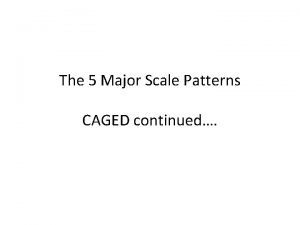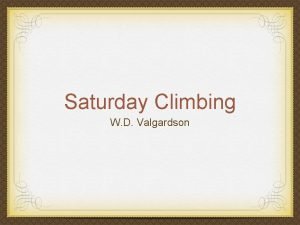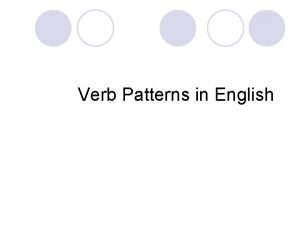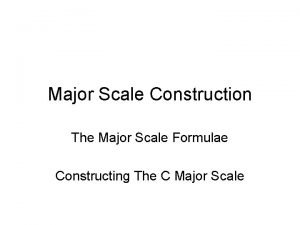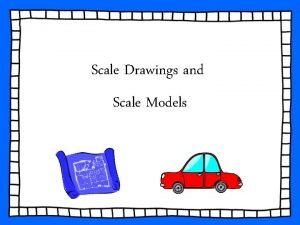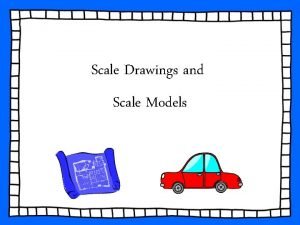The 5 Major Scale Patterns CAGED continued How









- Slides: 9

The 5 Major Scale Patterns CAGED continued….

How should I practice? Stage 1. Up And Down The first stage should be to be able to "cycle" the scale. That is to play it up and down over and over without stopping. This should be done with a metronome to be sure that the timing is even. Try also to focus on the volume of the notes that you play and try to keep it consistent. Be able to play the scale 4 times perfectly, without stopping before you move on. Stage 2. Random Direction Changes Once you can cycle the scale it is time to start changing direction at random. Start this slower than your speed for stage 1 and make sure that you play continuously. Don't pause, stop or start soloing (going off on one. . . ). Try and stick to it being scalular (don't skip notes). Stage 3. Random Notes Now it is time to explore the scale. Play random notes from the scale, be very careful to ONLY play notes from the scale. Play it slowly and get it right. It is easy to rush this one and make mistakes. DON'T MAKE MISTAKES. Ever. There is no point in practicing the wrong thing. Keep the notes evenly timed, explore skipping strings, jumping from very low to very high, generally explore the scale. You will find that this really tests your knowledge of the scale shape.

Continued… Stage 4. Play in 3 rd's As you may know, chords are built up in intervals of a 3 rd. This means that by playing notes that are a 3 rd apart they will tend to sound good together. Often melodies use chord tones, so after some time practicing this pattern, your improvising should start sounding more melodic. You can think of 3 rds as playing a note, then missing the next scale step and playing the next. Then go back to the note you missed, and go up a third again (skip a note. . . ). Stage 5. Four In A Line Another good pattern to get down is called four in a line. Start on the first note of the scale and play up four notes. Then start on the second note and play up four notes again. Continue this pattern up the scale and then back down. This is a good way of developing a "way out" of a scale, because you are playing four notes of a scale and then skipping.

Modes Ionian C Dorian D Phrygian E Lydian F Mixo lydian G Aeolian A Locrian B D E F G A B C A B C D E F A B C D C D E F E F G A G A B

Pattern 1 This is the first Major Scale pattern that most people learn and is based around the E Shape Major chord, the Root note is on String 6 and it's a very easy pattern to play.

Pattern 2 This pattern is easy to join up with Pattern 1 as it is next door, but rarely do people use it as a starting Major position, partly because the root note is on String 4 and some people don't know theor String 4 root notes as well as they should! It's also got a tricksty fingering to overcome.

Pattern 3 Many people like this scale pattern because it outlines it's parent C Shape major chord very clearly and is easy to play with no position shifts involved.

Pattern 4 Another important pattern to learn because it's based around the A Shape (which is 2 nd most common barre grip after the E Shape). There a few variations of this pattern worth exploring

Pattern 5 We're back with a String 6 root note now but played with our pinky finger. There are common variations to look at another fingering problem to solve!
 Major scale pattern 4
Major scale pattern 4 Saturday climbing frizzy haired girl
Saturday climbing frizzy haired girl Fat worms waiting on a dawn bright lawn
Fat worms waiting on a dawn bright lawn Com base no caged, considere as seguintes assertivas:
Com base no caged, considere as seguintes assertivas: Theme of the poem i know why the caged bird sings
Theme of the poem i know why the caged bird sings Dating patterns since the 1960s are
Dating patterns since the 1960s are X videos
X videos Noun pattern
Noun pattern What are the two major patterns of evolution?
What are the two major patterns of evolution? Different types of pubic hair
Different types of pubic hair
